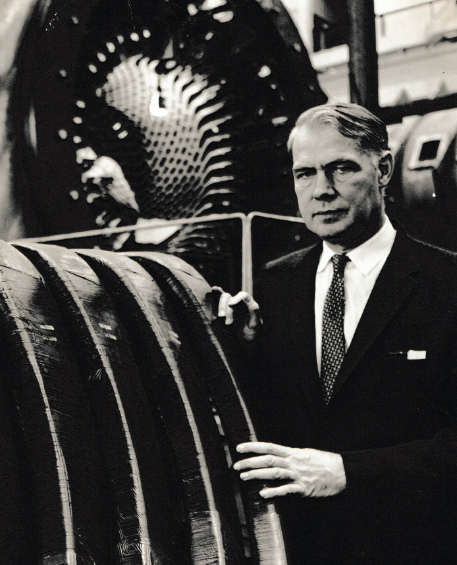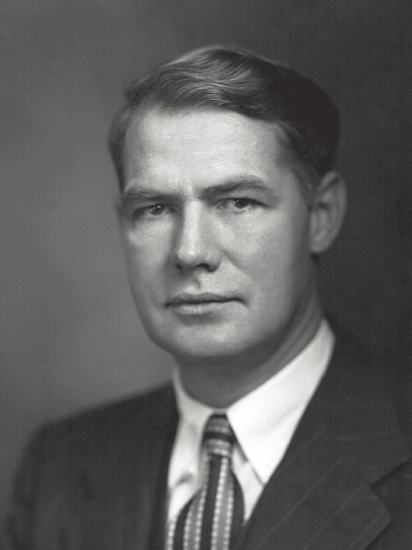

LEE A. KILGORE
1905–2000
Elected in 1976
“Contributions in electromechanical engineering, particularly in the development and design of large rotating electric machinery.”
BY JAMES KIRTLEY
LEE ALTON KILGORE, a pioneering figure in the electric power apparatus industry, passed away on October 23, 2000, at age 95.
He was born August 10, 1905, to Isaac Alton and Julia (née Kelly) Kilgore in Leavitt, Nebraska, a town that no longer exists in Dodge County. It had been built around a sugar beet refinery, and when that closed during Lee’s childhood the family moved to Fremont. Isaac Kilgore, who had very little education, was a sign painter who considered himself an artist and also wrote poetry.
Lee attended school in Fremont and later said that it was an excellent high school with a superintendent who insisted on hiring good teachers. Lee described himself as “a good student, near the top if not at the top” of his class.1 His brother, George Ross Kilgore, was a radio amateur, and Lee said he “dabbled in it” but was never good enough at Morse code to earn a general license. George went on to have a distinguished
___________________
1 This and other quotations are from an oral history conducted December 8, 1993, by William Aspray, IEEE History Center, Piscataway, NJ, http://ethw.org/Oral-History:Lee_Kilgore. The IEEE History Center has a collection of more than 800 oral histories in electrical and computer technology; they can be accessed via http://ethw.org/Oral-History:List_of_all_Oral_Histories.
career in electrical engineering himself and was awarded the Third Millennium Medal in 2000 by the IEEE Electron Devices Society.
In high school Lee worked at a tree nursery and saved enough money to attend the University of Nebraska, which he said he selected because “tuition was free” and his parents were unable to contribute to the expenses of his college education. During summers and breaks in the school year he worked as a lineman for Northwestern Bell and Lincoln Telephone Company. He majored in electrical engineering, with a focus on power, and graduated as one of the top students in his class in 1927.
During the summer after his junior year he enrolled in a program at Westinghouse called the Junior Student Course. He was assigned to build a small demonstration of a circuit breaker invented by Joseph Slepian, called the deion breaker. The basic principle of this circuit breaker was involved in magnetic blast breakers, which used a magnetic field to move a developing arc. Lee’s interactions with Slepian proved to be valuable in his career.
Degree in hand, Lee went to work at Westinghouse in East Pittsburgh, Pennsylvania, and attended classes at the University of Pittsburgh at night, earning a master’s degree in 1929. Working with Carl Soderberg, he contributed to the theory of transient behavior of turbogenerators. This involved a lot of experimentation and, in his words, “we…nearly wrecked one of the machines.” As a result, he learned something about bracing of armature windings and wrote a classic paper, “Calculation of Synchronous Machine Constants—Reactance and Time Constants Affecting Transient Characteristics.”2
Lee was engaged in the design of large generators and wrote a design manual for turbogenerators, based in part on the work of Benjamin G. Lamme but with much original material as well. He was responsible for the design, in 1934, of a 165 MW, four-pole generator that became the most highly rated generator in service for about 18 years.
___________________
2 Published in Transactions of the American Institute of Electrical Engineers 50(4):1201–13, December 1931.
Later, as manager of engineering, he oversaw the Westinghouse development of inner-cooled generators, in direct competition with Allis Chalmers and General Electric. All three companies were working on the same sorts of cooling techniques at the same time, although Kilgore said that GE was behind. He credited the invention of direct, inner-cooled generators to “a fellow named Baudry,”3 but, he said, “I got to present the thing to the Management Committee.”
Mr. Kilgore was diverted for 2 years to working, as the junior partner of Joseph Slepian, on the design of mercury arc rectifiers. In 1936 he designed an ignitron rectifier, the first of its kind.
In 1938 he was put in charge of large motor design. In his oral history, he said wryly, “but I hadn’t, say, designed a motor. Furthermore, they already had two excellent chaps: one on synchronous motors, Mr. Lory, who later became engineering manager of that whole group; and P.C. Smith, who had worked as an induction motor designer for 30 years before they had made him any kind of a supervisor.” Kilgore said he “applied myself mostly to developing better methods of calculation.”
As manager of motor design, among other responsibilities, during and after the Second World War,4 he developed motor and drive systems for large wind tunnels at Wright Field (now Wright-Patterson Air Force Base) and Moffett Field (now NASA Ames). These were quite large, variable-speed motors in applications for which stability is an issue. The job at Wright Field required a variable-speed 40,000 horsepower motor, and Westinghouse provided what was to become
___________________
3 René André Baudry was an engineer, section manager, and engineering department manager at Westinghouse for at least 40 years (1925–65).
4 He was also recognized, with an official certificate from the US War Department (Army Service Forces – Corps of Engineers: Manhattan District), for having “participated in work essential to the production of the Atomic Bomb, thereby contributing to the successful conclusion of World War II. This certificate is awarded in appreciation of effective service.” It was dated August 6, 1945, and signed by Secretary Henry L. Stimson. The nature of his contributions is not known.
known as a Kramer drive, with slip energy recovery through a motor/generator set. In Kilgore’s words, “You get an inherent instability in these things.” He figured out how to stabilize the system by picking an appropriate slip speed.
The system at Moffett Field was even bigger, involving six large motors, each driving a fan. To maintain uniform flow, all six motors had to be turning at the same speed, so a system of wound rotor motors with both primary and secondary circuits connected together was to be used. But it presented a bunch of different modes of oscillation, some unstable. Lee eventually figured out how to shape the torque/speed curve of the motors, using a tuned circuit, to force them to run together stably.
During the development of drives for wind tunnels, Lee found himself again competing with General Electric, and again coming out ahead. While he was running the motor design section, he also designed large motor/flywheel/rectifier systems for major physics experiments at the University of California, Berkeley, where he worked with Ernest Lawrence, and at Brookhaven National Laboratory. In his oral history, he described how Westinghouse had devised a relatively simple design for the flywheel/generator set using an ignitron rectifier. Lawrence had expressed some concerns about the Westinghouse design partly because of observations made by GE staff and partly because GE had made a proposal that was much more expensive. But Westinghouse got the job because Kilgore was able to cite experience that justified the parts of their proposal that had raised concerns, including peripheral speeds of the flywheel and possible misfiring of the ignitron devices.
In 1954 Kilgore became manager of engineering for the East Pittsburgh Division of Westinghouse. His responsibilities included motors, generators, and even switchgear. He noted that, while the generator engineers did a lot of calculations but very little experimentation, the switchgear groups in East Pittsburgh took a “cut and try” approach: the “circuit-breaker switchgear people never did any figuring—they didn’t even have a slide rule.” So he took to improving the analytical and experimental skills of the engineers, particularly in the
switchgear area, by teaching them “how to figure temperatures in their apparatus, and how to figure short circuits, forces, and stuff.” He also “prodded the generator people to make a nice laboratory.” Thus one of his major contributions was to help his staff develop both analytical and experimental capabilities.
In 1956 Kilgore received an honorary doctorate from his alma mater, the University of Nebraska. In 1959 he was honored by IEEE with the Lamme Medal, named for the same Benjamin G. Lamme who had led development of rotating electric machinery at Westinghouse early in the 20th century but who had passed away shortly before Lee started working at the company. His Lamme Medal citation was “for meritorious achievements in the design of electrical machinery; more specifically, for analyses of synchronous machine reactances, for inventions of special armature windings, and for inventions and designs related to large adjustable-speed alternating-current motors.”
When he was a couple of years from retirement, the job he had held was eliminated in a reorganization, so he became a “consulting engineer.” Beyond teaching about technical topics like engineering design, heat transfer, and field mapping, he also developed educational resources for his divisions. Together with two colleagues, he developed a course called “Human Relations for Engineers” that addressed a long-felt need at the East Pittsburgh works. This he taught personally to his engineering managers, with the idea that they would propagate it to their employees. He reported, “All together, we got at least 80 percent of the engineers in East Pittsburgh to go to a night course on their own time.”
Lee was active in the affairs of the American Institute of Electrical Engineers (AIEE) and its successor, the Institute of Electrical and Electronics Engineers. In addition to presenting his work at their meetings, he chaired the Electric Machinery Committee and the Power Systems Committee and participated in standards development. He was elected a fellow of AIEE in 1945.
Dr. Kilgore was, in his words, “well acquainted with” Charles Concordia (1908–2003) of General Electric, another
NAE member (elected in 1978). Another good friend and competitor was Sterling Beckwith (1905–92) of Allis Chalmers; he had worked at Westinghouse earlier in his career. Among his contemporaries at Westinghouse were John Calvert, who eventually left to teach at the University of Pittsburgh, where he became head of the Electrical Engineering Department, and Eugene Whitney (1913–98; elected to the NAE in 1986). During the period when GE, Westinghouse, and Allis Chalmers were developing inner-cooled generators, Kilgore said, Professor Calvert was speaking with both Kilgore and Beckwith, but sharing nothing said by one with the other. Lee shared a delight in the rivalry with GE’s Edwin Harder (1905–2004), a contemporary who was also awarded the Lamme Medal and elected to the NAE in 1976.
Lee was married to Ellen Connor Kilgore and they had four children, whom he regaled at the dinner table with tales of growing up in Nebraska. He belonged to a canoe club on the Allegheny River, where he and the family spent many happy hours, and he spent evenings in his easy chair making slide rule calculations to test out his engineering ideas. In retirement he used his artistic ability to make clay sculptures of scenes from his boyhood, animals, and busts of his grandchildren. He and Ellen enjoyed traveling to visit friends and family.
Ellen passed away in 1988. They are survived by their children Nancy Rice (Edward), Gordon, Susan Aoki (Thomas), and Robert, and eight grandchildren.
Lee Kilgore made important contributions to the design of electric power apparatus, including enhanced use of analytical techniques for design, and to the design of rotating machinery and switchgear, including field mapping techniques for understanding breakdown. He taught engineering analysis and design to numerous engineers at Westinghouse, where he also developed and taught about management of people. His influence on engineering design practice and on the modern power system continues.








